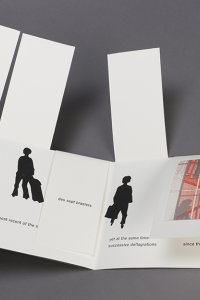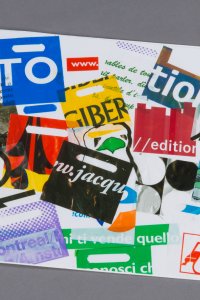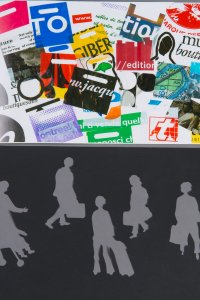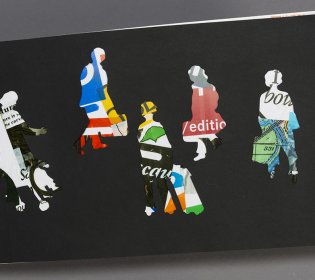Impermanence subtile. Subtle impermanence
Year: 2013
Author: Ian Monk (*1960)
Artist: Shirley Sharoff (*1936)
Publisher: Shirley Sharoff
A collage of garbage
One of Sharoff’s city books appeared in 2013: Impermanence subtile. Subtle impermanence. The text was set in Grotesque and printed in Vincent Auger’s Paris studio. It constitutes a fragment from the poem ‘Tri selon tri’ by the English poet Ian Monk (1960).
The title of this excerpt is a direct reference to Buddhist doctrine on the permanent inherent instability of life, the constant state of flux. The poet proposes supplanting four old categories with four new ones: the four elements of earth, air, water and fire have become outdated. What is to come in their place is ‘paper, plastic, glass’ and ‘in the end everything left over. Those things that finish up in their own trash can’. If one reads the entire ‘Tri selon tri’ poem it becomes clearer that the fourth category is ‘the rubbish bin’. It contains mealtime remains (potato peels, ketchup-stained serviettes) but also more intimate waste (dirty nappies and vomit) which, according to Monk, will mingle to form a potion ‘from hell’ for future generations.
The cover presents a collage of photos taken by Sharoff: a viaduct, a demolished house, a discarded egg box, a trailing traffic tape, junk that has been dumped. The etching shows city dwellers on the move, they continue perturbed by nothing. Sharoff also glued in cut-out black images of shoppers against a white background. The shapes left behind are invested with colour because the page beneath is simply a collage of labels, packaging and advertising material.
Bibliographical description
Description: Impermanence subtile = Subtle impermanence / Ian Monk ; gravures et découpages, Shirley Sharoff ; traduit en anglais par Shirley Sharoff et Richard Pye Subtle impermanence. – [Paris] : [Shirley Sharoff], [2013]. – 21 pages non numérotés : illustrations. ; 21x34 cm.
Printer: Atelier Vincent Auger (Parijs)
Edition: 35 copies
This copy: Number 6 of 35 on Rives BFK grey paper
Note: Original edition; text extracted from the poem ‘Tri selon tri’ by Ian Monk; set in typeface Grotesque; signed by the artist
Shelfmark: KW KOOPM P10049
References
- Paul van Capelleveen, 'Shirley Sharoff', in: Artists & others. The imaginative French book in the 21st century. Koopman Collection, National Library of the Netherlands. Nijmegen, Vantilt Publishers, 2016, p. 180-185.
- Paul van Capelleveen, Sophie Ham, Jordy Joubij, Voices and visions. The Koopman Collection and the art of the French book. The Hague, Koninklijke Bibliotheek, National Library of the Netherlands; Zwolle, Waanders, 2009.
- Christophe Comentale, ‘Les Amazones’, in: Art et métiers du livre, 249 (août-septembre 2005), p. 85.
- Christophe Comentale, ‘Bruits: sons et images’, in: Art et métiers du livre, 266 (mai-juin 2008), p. 87.
- Christophe Comentale, ‘Shirley Sharoff, des livres à tenir debout et des estampes à voir assis’, in: Art et métiers du livre, 231 (août-septembre 2002), p. 58-63.
- Christophe Comentale, ‘Les vagues’, in: Art et métiers du livre, 241 avril-mai 2004), p. 76.
- Marie-Paule Peronnet, ‘La marelle à trois temps’, in: Art et métiers du livre, 271 (mars-avril 2009), p. 87.
- Françoise Séloron, ‘Shirley Sharoff. L’art des signes urbains’, in: Nouvelles de l’estampe, 202 (novembre 2005), p. 67-69.
- ‘Shirley Sharoff. Signes de vie’ [website]: http://shirleysharoff.free.fr/.




